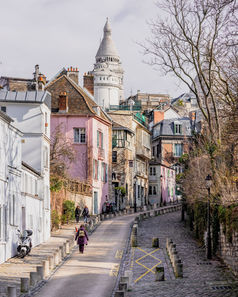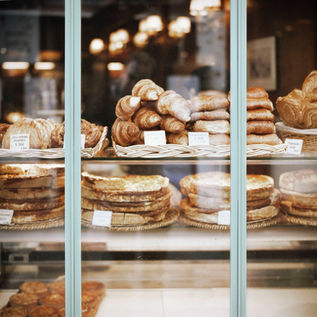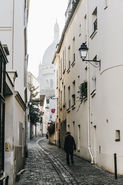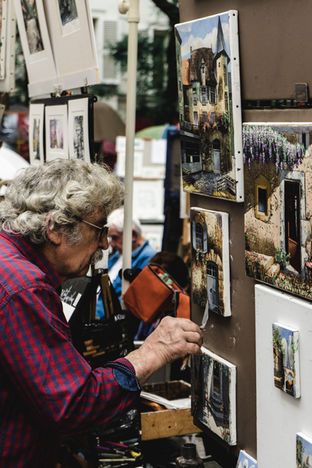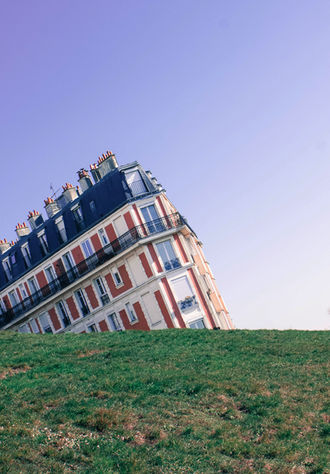
Montmartre
In the late 19th and early 20th centuries, Montmartre was the center of Parisian artistic life, with an exceptional concentration of artists' studios, cafés, art galleries and cabarets. Visiting Montmartre and the Basilica of the Sacré-Cœur is an unmissable experience for any traveler to Paris. This charming place offers a unique blend of art, history and romance that will leave you with unforgettable memories.
His history...
The Montmartre district is known for its picturesque architecture, including the Sacré-Cœur Basilica, which overlooks Montmartre Hill and offers panoramic views of Paris. The cobbled streets, stone staircases, cafes and artisan shops create a charming and romantic atmosphere, which continues to attract visitors from all over the world.
Many famous artists have lived and worked in Montmartre, including Pablo Picasso, Vincent van Gogh, Henri de Toulouse-Lautrec, Edgar Degas, Georges Braque and Amedeo Modigliani. Artists were attracted by the neighborhood's bohemian character and vibrant nightlife, as well as the creative and stimulating atmosphere.
Montmartre's influence on French art was evident in many artistic movements, including Impressionism, Post-Impressionism, and Art Nouveau. Montmartre artists also played an important role in the birth of modern art, with movements such as Cubism and Fauvism emerging in Montmartre in the early 20th century.
Montmartre and the Paris Commune, the other side of the story...
Montmartre was once a peaceful place, where artists and lovers converged to explore the cobbled streets and bustling squares. But the serene air was shattered by the bloody events of the Paris Commune in 1871.
The inhabitants of Montmartre joined the revolutionaries to fight against the centralized government and the troops of Versailles. They made the Sacré-Cœur their fort and fiercely defended it against the troops of the army.
The fight was bloody and brutal, the streets of Montmartre echoing with gunshots and cries of pain. The revolutionaries fought determinedly, but were ultimately defeated by the superior troops of the army.
The consequences were terrible. The revolutionaries were captured and executed, their bodies displayed in public squares to serve as a warning. The Montmartre district was devastated by the fighting, buildings damaged and the streets strewn with bodies.
The Terrible History of the Commune in Montmartre remained engraved in the collective memory of the neighborhood.
A Look at Toulouse Lautrec
Henri de Toulouse-Lautrec was a 19th-century French artist who spent much of his life in Montmartre. He is best known for his paintings and posters which captured the bohemian and festive atmosphere of Montmartre's nightlife in the late 19th century.
Toulouse-Lautrec was born in 1864 into an aristocratic family in southwest France. He fell victim to an illness which affected his growth, leaving him to reach an adult height of only 1.52 meters. This situation often excluded him from physical activities with his peers, and led him to focus on painting and art.
Toulouse-Lautrec settled in Montmartre in the early 1880s, where he quickly adopted the region's bohemian and artistic lifestyle. He became a regular at the cafés, cabarets and theaters of Montmartre, and began painting portraits of his friends and acquaintances, as well as scenes of nightlife.
Among his most famous works are posters for cabarets and shows in Montmartre, such as "Moulin Rouge - La Goulue" and "Jane Avril au Jardin de Paris". These posters became emblematic of the era and helped make Montmartre known as an important cultural center of Parisian nightlife.
In addition to his paintings and posters, Toulouse-Lautrec was also a great collector of lithographs and engravings. He amassed an extensive collection of these works, which influenced his own artistic style and helped popularize these techniques among artists of his time.
Toulouse-Lautrec died in 1901, aged just 36, largely due to his excessive use of alcohol and drugs. However, its artistic legacy survived and became an integral part of the history of Montmartre and Parisian nightlife of the late 19th century. Today, his works are exhibited in museums around the world and continue to inspire contemporary artists.
When Montmartre inspires other artists...
-
Pablo Picasso - the famous Spanish artist lived and worked in Montmartre for several years, and painted many portraits and scenes of neighborhood life.
-
Vincent van Gogh – although the famous Dutch painter spent most of his artistic career in France, he also spent some time in Montmartre.
-
Amedeo Modigliani - the Italian artist spent most of his career in Paris, and lived and worked in Montmartre for a time.
-
Georges Braque – the French painter and sculptor is often associated with the Cubist movement, and also lived and worked in Montmartre.
-
Maurice Utrillo – the son of Montmartre singer Suzanne Valadon, painted many cityscapes of Montmartre.
A nostalgic place...
The Bateau-Lavoir was a phenomenon of the Montmartre art scene at the turn of the 20th century. This small building, which originally served as a laundry room for the residents of the neighborhood, has become a mecca for artistic bohemia in Paris.
Many famous artists frequented the Bateau-Lavoir, including Pablo Picasso, Georges Braque, Juan Gris, Max Jacob, Guillaume Apollinaire and many others. It was here that Picasso painted his famous painting Les Demoiselles d'Avignon in 1907, a work considered the starting point of the Cubist movement.
The Bateau-Lavoir was a place of meeting and creation for artists from Montmartre, who then lived in precarious conditions. They met to discuss their works, exchange ideas and support each other in their artistic practice. The Bateau-Lavoir was a place of freedom and creativity, where artists could explore new forms of artistic expression without being limited by academic conventions.
Today, the Bateau-Lavoir is nothing more than a memory, the original building having been destroyed in 1970. However, its influence on the history of art remains undeniable.
 |  |  |
|---|---|---|
 |  |
A visit itinerary among others
To visit Montmartre, it is advisable to go to Place du Tertre, where there are many street artists and small restaurants. You can also stroll the cobbled streets to discover the pretty, colorful houses and charming little cafes.
The Basilica of the Sacré-Cœur is another point of interest that is impossible to miss in Montmartre. This white basilica located on the hill offers a breathtaking view of the city. To visit the basilica, you can climb the steps to the top of the hill or take the funicular.
Once inside, you can admire the delicate frescoes on the vaulted ceiling and the colorful stained glass windows that filter the sunlight. It is also possible to stroll out onto the balcony to admire the panoramic view of the city.
If we had to select a few unmissable places in Montmartre we would say:
-
The Sacré-Cœur Basilica – this iconic church sits atop Montmartre Hill and offers stunning views of Paris. It was built in the late 19th century in response to the French defeat in the Franco-Prussian War of 1870.
-
Place du Tertre - this square is famous for its street artists selling their works and the many cafes and restaurants surrounding it. It's a great place to have a drink and enjoy the bohemian atmosphere of Montmartre.
-
The Moulin Rouge - famous cabaret in Paris, located at the foot of Montmartre hill. The Moulin Rouge is known for its dance shows, flamboyant costumes and festive atmosphere.
-
Rue des Abbesses - a lively and shopping street in Montmartre, with many shops, cafes and restaurants. It is famous for its food market, which takes place every Wednesday and Saturday.
-
The Jardin des Abbesses - a small, picturesque park located near Rue des Abbesses, with benches and a fountain. It's a nice place to relax and enjoy the sun.
-
Dalida's house - this villa in the Montmartre district was the residence of the Italian singer Dalida for many years. It is now a museum dedicated to his life and career.
Finally, to fully enjoy your visit, don't forget to taste the local cuisine, visit the region's art museums and participate in cultural activities such as cabaret shows.
The Montmartre funicular is a convenient and fun way to go up to the Sacré-Cœur Basilica. It is located at the intersection of rue Foyatier and Place Saint-Pierre, and is open every day.
To take the funicular, you will need to buy a ticket from a vending machine or at one of the ticket offices at the entrance. It is also possible to use a public transport ticket such as the Navigo ticket or a Paris Visite card pass.
Once you have your ticket, head to the carriages and board. The funicular will take you smoothly to the top of the hill, where you can visit the Basilica of the Sacré-Cœur and admire the view of the city.
























Some Unusual Places in Montmartre



The Wall of I Love You is a contemporary work of art at Place des Abbesses. This artistic installation was created in 2000 by Frédéric Baron and Claire Kito, two French artists, and is located in Square Jehan Rictus.
The Wall of I Love You is made up of blue and white ceramic tiles arranged on a square-shaped wall 10 meters wide. On each tile, the word "I love you" is written in more than 300 different languages, representing the universality of love.
This work is designed to be a romantic meeting place and a symbol of universal love. Visitors are encouraged to take photos, add their own love language on the blank white tiles and express their love by writing their own "I love you" in different languages.
The Wall of I Love You is an example of contemporary art that seeks to create accessible and universal works that can be appreciated by everyone, regardless of age, gender or culture. This public art installation also has a deeply human message that celebrates the love and diversity of world cultures.




The Abbesses church is located on rue des Abbesses. It was built during the 19th century in a neo-Gothic style by the architect Jean-Baptiste Lassus and the engineer Théodore Lefebvre.
The Church of the Abbesses is a remarkable example of 19th century religious architecture in France. It is notable for its use of the Gothic style, which was very popular at the time, as well as its large size and elaborate structure.
The church is dedicated to Saint Jean de Montmartre, the patron saint of Montmartre Hill, and it is also known as the Minor Basilica of the Sacré-Cœur de Montmartre. It is characterized by its two towers, which rise more than 60 meters high and are visible from afar in the neighborhood.
The interior of the Church of the Abbesses is just as impressive as its exterior. It is home to many architectural and artistic features, such as colorful stained glass windows, marble statues, murals and frescoes. Visitors can also admire the church's impressive organ, which was built by the famous organ builder Aristide Cavaillé-Coll.
The Church of the Abbesses is an important place of worship for the Catholic community of Montmartre, but it is also open to visitors who wish to discover 19th-century religious architecture in France. It is a remarkable example of the art and architecture of its time and testifies to the importance of religion in the social and cultural life of 19th century France.




The Montmartre vines are a symbol of the Montmartre district of Paris. This is a small vineyard located at the top of the Montmartre hill, which produces around 1000 bottles of wine each year.
The vines of Montmartre have a long history dating back to the Middle Ages, when Montmartre was an important wine-growing region in France. However, by the end of the 19th century, the rapid urbanization of Paris led to the disappearance of most of the region's vineyards.
It is in this context that the association "Les Amis de Montmartre" decided to replant a small vineyard on the hill of Montmartre in 1933, in order to preserve the region's wine-growing tradition and promote the cultural identity of the neighborhood.
Today, the vineyards of Montmartre cover an area of approximately 1600 m² and mainly produce red wine from Gamay and Pinot Noir grapes. Each year, the harvest is celebrated during the Fête des Vendanges de Montmartre, a festive event that attracts thousands of visitors from all over France and around the world.

Image Gallery









